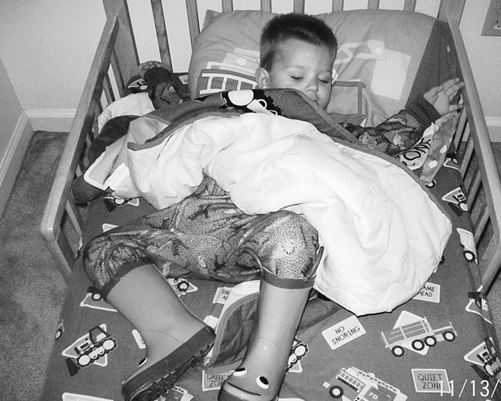The No Cry Nap Solution (16 page)
Read The No Cry Nap Solution Online
Authors: Elizabeth Pantley
Inconsistent, or Nonexistent
Many times, the steps in the prenap routine are misaligned, so
they don’t aid in helping a child sleep. For example, if you get
a child cozy in bed and then get back up to use the potty and
wash hands, then your child may lose whatever relaxing state he
acquired during your wind-down routine. Or, perhaps there is no
prenap routine at all—a child engaged in play is suddenly whisked
off to bed and expected to fall asleep. Without a good routine, it’s
natural for your child to resist a nap.
Solutions
A calming prenap routine sets the stage for sleep. A nap routine
doesn’t have to be long or complicated to be effective. What’s
important is that the routine is consistent from day to day and
that it helps a child prepare for rest. Often a mini-version of the
bedtime routine is best, since a child is already familiar and com-
fortable with the nighttime routine. So, as an example, if you read
for twenty minutes before bed at night, you might read for ten
minutes before a nap. If singing a lullaby occurs before bedtime,
you might incorporate the same song or a similar one into your
prenap routine.
If your child is old enough to understand it, you can create a
naptime poster and hang it on the wall. It can have simple pic-
tures (or photos of your child) that show the steps to naptime.
That way, he can be involved in orchestrating the steps and be
more accepting of the process. An older child can often be moti-

96 Solving Napping Problems
vated with a nap calendar on which he can put a sticker each day
after he wakes up from his nap.
Problem: Too Busy
Children have an incredible amount of energy. While most adults
would love to have someone tell them to take a nap, most chil-
dren resist even the idea of slowing down. Children may be afraid
that if they take a nap they will miss out on “something.”
Solutions
In order to help your child welcome his nap or rest time, avoid
letting him get involved in a fun activity right before naptime.
If your child is beginning to build a wonderful castle of blocks or
has just opened a new tub of clay, she’ll be reluctant to leave her
Adriane, three years old
The Nap Resister
97
project to take a nap. End any exciting activity a half hour or so
before naptime. Help your child switch gears to something mel-
low. That way, when you move toward naptime, he won’t fi ght you
to continue playtime.
As you set your child up for a nap or quiet time, let him know
what he can look forward to when he gets up. Tell him that by rest-
ing he’ll have more energy to enjoy the afternoon plans. Explain
what you’ll be doing as he sleeps, and make it sound boring, such
as “I’ll be doing paperwork while you sleep.” Saying this lets your
child know he won’t be missing anything exciting and that the
fun stuff will happen when he wakes up.
Parents often pull a child away from a fun activity and take
him to a boring crib or bed for naptime. You can make an easier
transition by allowing him to nap in a more interesting place: cre-
ate a fort out of a bedsheet and table with a pillow and blanket
inside, put a sleeping bag on the fl oor in your offi ce, or take a rest
with your child. Few children will resist napping with mommy or
daddy! (And the nap is good for you, too.)
Problem: Sneaky Micro-Naps
The very fi rst stage of sleep can last as little as fi ve minutes and
can reduce the feelings of sleepiness brought on by homeostatic
sleep pressure—it lifts the lid and lets the steam out just enough.
If your child hits a tired zone and is lying on the sofa or going for a
ride in the car, he may nod off for fi ve or ten minutes. This micro-
nap doesn’t give your child the full benefi t of a real nap but can be
just enough to rejuvenate him and prevent him from being able to
sleep when you put him in bed later for a nap.
Solutions
Avoid putting your child in a nap-inducing environment, like a
ride in the car, at a time when he’s likely to need a nap, unless you
98 Solving Napping Problems
can leave him for a full nap. Schedule your days, when possible, so
that you are home at naptime. Take advantage of carpools, baby-
sitters, or schedule fl exibility.
If it’s impossible to avoid driving during your child’s tired spell,
then plan for a car nap. Turn on soft music or a white noise CD;
keep a book, knitting, your computer, or paperwork in the car;
and park to allow your child to take a real nap in his car seat. To
make this safe, tilt your child’s seat back (if it has this feature) or
let your child rest with a child-sized neck pillow to prevent him
from slumping over in his seat.
Keep aware of your own needs for sleep. If the car is set up to
be a relaxing environment and you are sleep-deprived, then you
may fi nd that this isn’t a good idea, as you don’t want to be driving
while drowsy. Stay safe and stay home, nap along with your child,
or revamp your own sleep routines so that you aren’t feeling so
sleep-deprived.
Problem: Separation Anxiety
Separation anxiety can pop up at any age and become an obstacle
to napping. Babies can suddenly have doubts when a parent leaves
the room—
Where did mommy go? Is she gone forever?
This can pre-
vent a baby from relaxing enough to fall asleep.
Separation anxiety is very common all the way up through
the preschool years. It’s a sensible fear: children who feel safe and
secure when their caregivers are close by may feel unsettled when
they must separate from them to lie alone in a dark room.
Solutions
Maintaining a consistent prenap routine is an important com-
ponent to overcoming separation anxiety. It may help to use
soft music during the nap as a transition from being with you to
being alone. You might also encourage your child’s attachment
The Nap Resister
99
to a stuffed animal or special blanket; these are called “security
objects” or “loveys,” and they can give your child something to
keep him company when you aren’t there. Living company can
be helpful too: a goldfi sh, turtle, or guinea pig as a bedside pet can
provide some comfort to a child who doesn’t want to be alone.
Reassure your child when she goes down for her nap that you
are just down the hall and you’ll see her as soon as she wakes up.
Keep the door open or turn on a baby monitor and go to your
child the minute you hear that she is awake. Sometimes a prenap
discussion about where you will be while she is sleeping and then
chatting about what is planned for when she wakes up can help
encourage a peaceful sleep.
There is another way to solve naptime separation anxiety, if
you wish. Set up a sleeping place close to wherever you will be
spending the time. If you have a baby, use a cradle or stroller and
park your baby next to you. An older child can be set up on the
sofa or in a sleeping bag on the fl oor. Let him know that he can
stay there as long as he keeps his eyes closed and rests, but if he
gets up, he’ll need to move to his bedroom.
One more way to solve naptime separation anxiety is to rest
with your child. Play soft music, white noise, or an audiobook.
Once your child is sleeping soundly, you can get up. That is, if
you’re not sleeping, too! If you
do
fall asleep, it’s because your body
needs that sleep. Research tells us that a short siesta midday is
extremely benefi cial for adults, so you’ll be improving your own
health and wellness with this daily rest.
Problem:
Thinks
He Has Outgrown Naps
Typically, children are ready to give up daily naps sometime
between the ages of three and fi ve
if
they get an adequate amount
of nighttime sleep. However, a good percentage of children con-
tinue to need a daily nap; 65 percent of three-year-olds, 25 percent
of four-year-olds, and 15 percent of fi ve-year-olds still take naps,

100 Solving Napping Problems
Benjamin, two years old
and it’s very likely an additional percentage should be napping
even though they aren’t. Plenty of children believe that they are
too old for naps; since many of their peers have stopped napping
they think they should, too.
Solutions
Possibly the best way to contend with a child who thinks he has
outgrown naps is to eliminate the word
nap
from your vocabulary.
Instead of making the dreaded naptime announcement, offer your
child a series of choices that lead her in your intended direction:
“What books do you want to read today?” “Do you want to lis-
ten to music or birdsong?” “Which stuffed animal do you want to
cuddle?” Older toddlers and preschoolers love having choices, and
they are more likely to cooperate if they are making the decisions
themselves.
The Nap Resister
101
You may want to implement the Hush Hour, described starting
on page 120. Your child may be open to a rest time versus a sleep
time. Teach him that it’s important to have a daily break in order
to enjoy the day and have more fun. Help him understand his own
sleepy signs. “When you start to get grumpy that means your body
is saying it needs you to take a break. You’ll feel much happier
when you get up.”
You may want to invite your child to create a solution. Many par-
ents suffer through the nap/no-nap war yet never think to include
their child in coming up with the right solution. Preschoolers can
often contribute valuable ideas, and if they are involved with creat-
ing solutions, they may be more likely to cooperate with the plan.
Problem: Has Truly Outgrown Naps
Sometime between the ages of three and fi ve, most children are
able to give up their daily naps without devastating effects. How-
ever, the journey between needing a nap every day and not need-
ing naps at all is not a straight line. Most children spend months
or even a year in an in-between place where they sometimes need
a long nap, sometimes need a short nap, and sometimes just need
a quiet rest break.
Solutions
Stick with a napping schedule for as long as you can. If you sus-
pect your child may be outgrowing naps, then it’s a good time to
read the chapter “Shifting Schedules: Time to Give Up Naps?”
Even after your child gives up naps for good, though, he can still
benefi t from a daily quiet time to recharge his energy. The ideas
for creating this rest break, called a Hush Hour, are also described
in that chapter.
